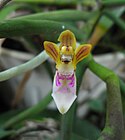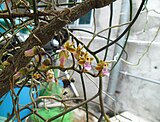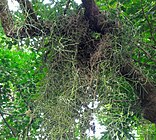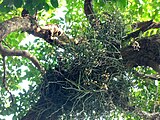| Cleisostoma simondii | |
|---|---|
 | |
| 1822 illustration from Botanical Register | |
| Scientific classification | |
| Kingdom: | Plantae |
| (unranked): | Angiosperms |
| (unranked): | Monocots |
| Order: | Asparagales |
| Family: | Orchidaceae |
| Subfamily: | Epidendroideae |
| Tribe: | Vandeae |
| Subtribe: | Sarcanthinae |
| Genus: | Cleisostoma |
| Species: | C. simondii |
| Binomial name | |
| Cleisostoma simondii (Gagnep.) Seidenf. (1975) | |
| Synonyms[1][2] | |
| |
Cleisostoma simondii is a flowering plant that grows upon larger trees, and known in Hong Kong as (Chinese:蜘蛛蘭). It also occurs in the Himalayas (Nepal, Bhutan, India, Assam), Cambodia, Laos, Myanmar, Thailand, Vietnam, and other parts of China (Fujian, Guangdong, Hainan, Yunnan).[1][3]
Contents
[hide]Etymology[edit]
The name "Cleisostoma" derives from the Greek words kleistos, meaning "closed" and "stoma" meaning "mouth".[4]
Description[edit]
Cleisostoma simondii grows to a length of 30–40 centimetres (12–16 in) or more, with numerous aerial roots that grow out of the stems. This hardy orchid grows thin, stem-like jointed leaves 10–28 centimetres (3.9–11.0 in) long that are fleshy, terete, linear year round, with the whole plant colors ranging from green to dark green under humid, low light conditions, to red to purple under drier more sunlit conditions. The flowers buds develop in late September, blooming long-lasting flowers from October to early November, on a spike up to 10–15 centimetres (3.9–5.9 in) long, composed from one to eleven flowers, averaging six to seven flowers, with each flower averaging 1.5 cm (15mm) in diameter.[3] [5][6][7]
Varieties[edit]
Two varieties are recognized:[1]
- Cleisostoma simondii var. guangdongense Z.H.Tsi - Fujian, S Guangdong, Hainan
- Cleisostoma simondii var. simondii - Yunnan, Himalayas (Nepal, Bhutan, India, Assam), Cambodia, Laos, Myanmar, Thailand, Vietnam
Gallery[edit]
Plants often ascending. Stems to 50 cm, rather slender, ca. 4 mm in diam., usually branched, many leaved, internodes 1-2.5 cm. Leaves terete, 7-11 cm × ca. 3 mm, slender, fleshy, obtuse. Inflorescence lateral, ascending, longer than leaves, unbranched or sometimes shortly branched, many flowered; floral bracts ovate, ca. 2 mm, membranous. Flowers yellowish green with purplish red veins, subfleshy; lip mid-lobe purple-red or yellowish white; pedicel and ovary 7-10 mm. Sepals oblong, 6-7 × 3-4 mm, rounded; lateral sepals slightly oblique, basally with 1/2 width adnate to column foot. Petals similar to sepals and smaller, obtuse; lip lateral lobes erect, deltoid; mid-lobe ovate-triangular, thickly fleshy, apex acute, base with a central triangular projection; spur subglobose, laterally compressed, ca. 4 mm in diam., apex concave, interior distinctly septate, with a back wall callus; callus either 3-lobed and T-shaped or subquadrate; mid-lobe subcuneate, centrally slightly concave, base shallowly bilobed and densely papillate-hairy. Column ca. 3 mm, densely white hairy at base in front; rostellum broadly triangular; anther cap slightly elongate and subtruncate at apex; stipe nearly suborbicular, base folded; viscidium saddlelike, large. Fl. Sep.
Epiphytic on tree trunks or lithophytic on rocks in forests or in open forests along rivers; 500-1200 m. Fujian, S Guangdong, Hainan, S Yunnan [NE India, Laos, Thailand, Vietnam].
CITIES category : Appendix II
References
1.Ref 1
2.Ref 2




No comments:
Post a Comment